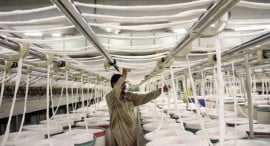
ISLAMABAD:
Making the past relevant in the technologically advanced age of today and tomorrow is the theme of this year’s World Museum Day.
Pakistan Monument Museum narrates the nation’s history from the great civilizations of Gandhara, Indus and Mehergarh.
“The biggest challenge is to present the past in a way that is dynamic and real to individuals who may not be privy to the exhibits’ history,” said Lok Virsa Executive Director Khalid Javaid, who was affiliated with the project.
We paid special importance to documenting exhibits from early societies, he stated. “History has a lasting impact on the present. Relics from Mehergarh are still part of Baloch culture just like the oxcart from the Indus civilization is still seen on our roads.”
“My generation has been able to see some of these historical events in real life and it is our duty to share these experiences, this is the only way a country’s heritage and culture can survive,” Javaid said. This was the reason three-dimensional displays were chosen to engage the imagination of the youth, he added.
The first displays revolve around the Indus valley civilization, Buddha and Gandhara art, showing the illustrious history of the subcontinent before the Arabs came.
In an increasingly globalised world, the museum displays exhibits from yesteryears when national boundaries were fluid leading to shared culture and history.
This focus on the earliest societies is a novel approach to national identity, denoting that our collective culture precedes 1947. However, displays titled ‘Quaid’s Relics’, ‘Iqbal’s Relics’ and the simulation of the first parliament session capture events related to the creation of Pakistan.
Thanks to generous foreign funding, Lok Virsa will launch a series of cultural festivals as well as building museums in various cities. To encourage visitors, tickets on World Museum Day will be sold at half price.
Meanwhile, hundreds pass by the 75-foot long skeleton of a blue whale standing tall at the entrance to Museum of Natural History, but very few stop to give it a look. Even fewer visit the museum.
Established in 1976, the museum is more than just a storehouse for 600,000 species of plants and animals collected from across the country.
Balochistan province once had thick green forests. If man-induced climatic changes are not checked, fertile land may also turn barren tomorrow. “This is one lesson that we learn by seeing Baluchitherium in the museum,” said the museum’s director general, Dr Azhar Hassan.
Describing the extinct genus of gigantic hornless rhinoceros-like mammals, Hassan said the Baluchitherium, first discovered in Balochistan, existed for approximately 14.17 million years.
Displayed against a backdrop of its natural habitat, it is the largest land mammal ever discovered, larger than the largest species of mammoths.
Dr Hassan said the mammal was herbivorous, providing evidence for thick forests in Balochistan. This mammal is being recreated in fibre glass and will soon be part of the collection.
He said the museum was providing hundreds of researchers with a platform to study the history of life. There are artifacts showing cave life and the evolution of man, which are unique to the museum.
Published in The Express Tribune, May 18th, 2012.





















































COMMENTS
Comments are moderated and generally will be posted if they are on-topic and not abusive.
For more information, please see our Comments FAQ